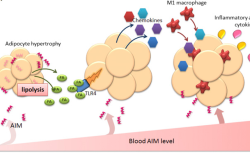Obesity in their sights AIM could transform our understanding of diet

A research team under Professor Toru Miyazaki at the University of Tokyo’s Institute of Medicine has determined the key protein that triggers many of the problems associated with obesity.

A scheme for the putative role of AIM in establishment of adipose tissue inflammation and insulin resistance. (Click on image to view full size) Reproduced with permission from Proceedings of the National Academy of Sciences USA 2011
Obesity and the health problems that accompany it are among the most pressing modern health issues. Yet while inflammation was known to cause diabetes and other problems, the process that brought about that inflammation remained unknown.
Ten years ago, Miyazaki discovered the protein AIM (apoptosis inhibitor of macrophage), and he showed in 2010 that AIM triggers the breakdown of fat in fatty tissue. By using a range of genetic engineering and traditional techniques, both in vitro and in vivo, Miyazaki’s team has now shown that AIM is the trigger for inflammation and the health problems associated with obesity.
Miyazaki likens AIM to the brake of a car, acting to reduce the amount of fat stored when a person starts to get fat. The problem with obesity is that people keep their foot on the accelerator at the same time by continuing eating, and so fat keeps on being stored away in the body and the amount of AIM continues increasing. Over a certain threshold, AIM triggers the negative effects of obesity.
It is very difficult to adjust our modern lifestyles to avoid becoming overweight, but Miyazaki argues the medical profession still has a responsibility to act to reduce the impact of obesity where it occurs. One way in which this might be achieved is through administering AIM-inhibitors to prevent triggering secondary diseases. As this would also have the negative effect of increasing weight, it is not without problems as a treatment. Another possible target of future research is into which types of food induce AIM release, and which do not. This could help people choose foods which stimulate the release of fat from fatty tissue.
Department release/press release (Japanese)
Papers
Jun Kurokawa, Hiromichi Nagano, Osamu Ohara, Naoto Kubota, Takashi Kadowaki, Satoko Arai, and Toru Miyazaki.,?
“Apoptosis inhibitor of macrophage (AIM) is required for obesity-associated recruitment of inflammatory macrophages into adipose tissue”,?
Proceedings of the National Academy of Sciences of the United States of America. Published online before print July 5, 2011. doi: 10.1073/pnas.1101841108
Article link
Supplemental information
J.?Kurokawa, S. Arai, K. Nakashima, A. Nishijima, K. Miyake, R. Ose, M. Mori, N. Kubota, T. Kadowaki, Y. Oike, H. Koga, M. Febbraio, T. Iwanaga, T. Miyazaki.,
“AIM is endocytosed into adipocytes and decreases?lipid droplets via inhibition of fatty acid synthase activity”,
Cell Metablism.?11: 479-492 ,2010. doi:10.1016/j.cmet.2010.04.013
Article link







